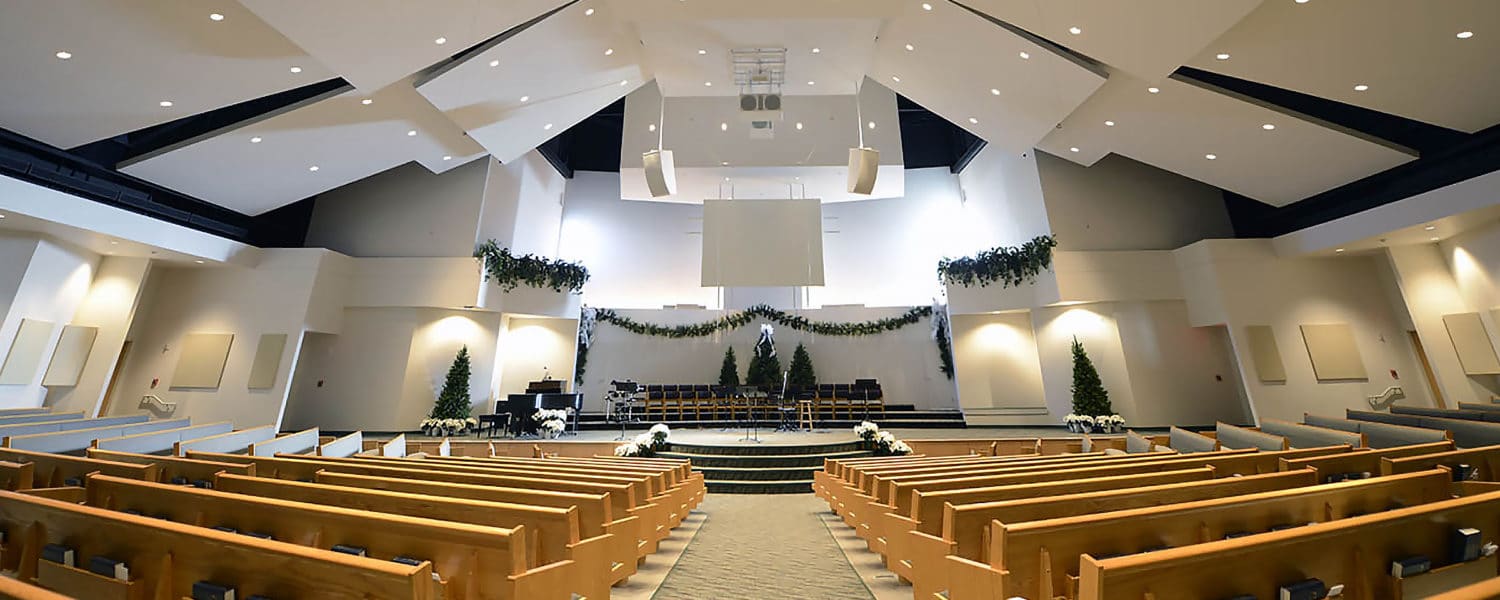By Jim Schwenzer
As AV professionals, when we think of a megachurch, we typically don’t visualize the size of the building first. Rather, we think of the production quality – the visuals, the sound, the energy – that charges the worship experience. Megachurches didn’t get big and then improve their production. They grow by presenting a top-level experience to the congregation that keeps them coming back.
In today’s professional audio market, there is a great opportunity being presented to small and medium-sized churches across the world: your worship space can achieve high-end production quality right now, for a fraction of the cost of what was once expected.
Thanks to industry-wide innovation, as well as influence from other markets, the ability to provide professional-grade audio is no longer relegated just to the big spenders in the worship community. Specifically designed systems, using the right solutions and products, now exist to bring high-quality audio to worship spaces of all size and shape.
The professional audio space is now a buyer’s market. This is a huge opportunity for every house of worship to consider.
However, the solutions available have never been more numerous than they are right now. The product lines are broad in terms of quality, performance and feature sets. How do you determine what is the right set up for your specific venue?
The best practices here are to identify the needs of your worship environment, seek out partners who are invested in your long-term success, and integrate a complete system that works for your space.
Identify Tricky Spots in Your Space
The reality of many worship environments is that they include unique features in terms of room size, shape and finish. High ceilings make an impact just as much as balconies and overhangs. Unique angles and non-traditional architecture abound in house of worship design. The ornate finishes and hard, reverberant materials used to adorn the space also make a difference.
Bottom line: There is no one-size-fits-all solution.
That said, there are some key things to consider when you prepare to design an audio system:
- Know the dimensions to your space – the length, width and height – as they play a key role in determining how much power your system will require.
- If your space isn’t a perfect rectangle, then know the shapes it includes. Curved walls – either inward or outward – create issues in focusing sound. Odd angles can also affect phasing, requiring addition of time aligned nearfield speakers in strategic areas of the room to restore clarity. These are problems that can be mitigated, but are good to be aware of before entering the system design phase.
- From what material is the space actually made? Are there hard surfaces, soft surfaces, or a combination of both? The difference here has to do with if the space will reflect or absorb sound.
- What else in the space might reflect or absorb sound? Pews often contain both hard and soft surfaces and introduce new angles to your space. Balconies and overhangs add an extra layer to the design. Are there any particularly ornate decorations on the walls that might affect the sound? Taking note of these at the start of the design is important.
What Will You Use?
While the differences in church size is important, so is the use of the space. Not every worship space needs to be a concert hall – but even a meditative and reflective service can benefit from the appropriate audio.
Things to consider:
- What percentage of typical use is limited to speech? How many presenters are there? Where do they do their speaking? Do you want to use wireless microphones or have set microphone positions? Understanding the number of microphone inputs as well as the amount of mixing that might be needed is an important consideration, as you want to deliver crisp, clear sound throughout the service.
- How much music is there and where does it come from? Is music being played mostly from an external audio source or is there a live organ or piano? What about a full band? Is there a choir, and, if so, how often do they perform? Does the choir director need their own control unit? If so, how technical does that control need to be?
- How loud do you get? There is a difference in power requirements between a choir and a full band with drums and guitars. Both can sound excellent – but they don’t have the same needs. If you are looking to really get a concert going, there are affordable options to ensure you have the right power in your workflow. House of worship spaces often struggle with finding a balance between clear, intelligible, spoken-word coverage and energetic live music coverage. The solution is both proper loudspeaker placement and amplifier quality and headroom.
- How much support staff do you have? Is there someone interested in learning a complex system? If not, is there someone who is happy to run a simple system? Do you need an “EZ-Mode” that allows you to set and forget?
- What other technology is involved? Do you have an inductive loop for those using hearing aids? If so, consider how that works with the system. Do you implement multimedia in the service, or do you broadcast out live video? These items should also be considered when designing the system.
What to Do with This Information
Once you’ve considered the above questions, seek out both manufacturers that offer easy-to-contact support and integrators who are involved in your community. They will ask you similar questions and you’ll be ready to answer.
To give you an idea of what solutions look like in this space, small churches can often utilize a setup where a single media amplifier has the full suite of Digital Signal Processors (DSP) settings built in. There are models that can offer a full 8-in x 8-out matrix mixer, where any input can be assigned to any output or outputs.
Along with the correct speakers and microphones, these media amplifiers can work as a sort of pro audio system in a single box. EZ-Mode settings also allow integrators to preset audio and allow individuals with no technical background to quickly and easily change between setups for services, weddings, or other meetings.
Medium-sized churches will start to implement new solutions such as low impedance cabinets that bring in higher powered subwoofers and the like. Good quality low impedance speaker cabinets will give these larger spaces higher-level audio quality and better fidelity.
At this level, you might also start to look at expandable DSP matrix processors that allow for input/output matrixing with signal processing. High-efficiency, high-power amplifiers are also likely to be added. This is also the level where a mixing board to control the system may be added, as well as offering control for the choir director through a remote or mobile app.
The largest churches will be looking at full integrations of network-enabled DSP processors and high-end amplifiers. At this point, it may be advantageous to delve into the world of network audio, thereby eliminating potentially hundreds of copper wire interconnections by routing all audio signals through a simple network. This simultaneously saves on cable expense and labor costs, while improving upon reliability.
That said, your local professional audio integrator will know the specific solutions that work best. If you can’t find a local integrator, contact a manufacturer and ask to speak to a sales representative. One thing that the size or shape of your church should never affect is the level of support a manufacturer is willing to give you.
As we talked about earlier, providing quality audio can be the first step in growing your house of worship – and you should find a manufacturer who will partner with you in that journey.
Jim Schwenzer is the director of service & technical support for Ashly Audio, www.ashly.com.












